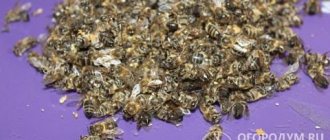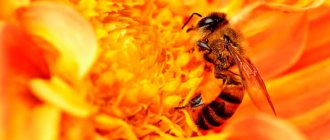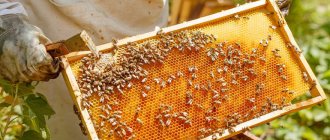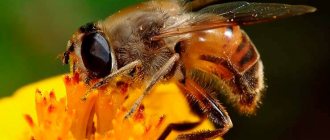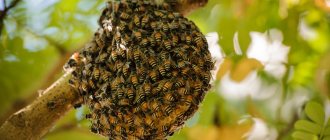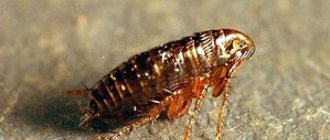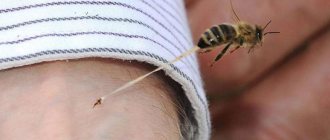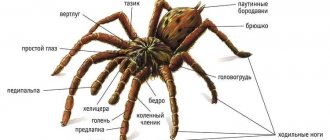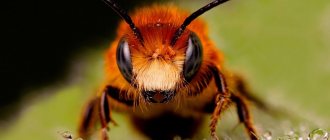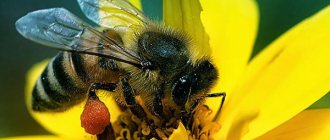Ground bees, insects that live in the soil, make nests in dug tunnels. Single individuals are often found in clearings and forest edges. Bee colonies sometimes settle in summer cottages, which poses a danger to humans. Bites often lead to side effects and unpleasant consequences. Therefore, it is better to get rid of these “neighbors” in a timely manner.
Appearance and features
Ground bees have distinctive characteristics: black body color, black-brown head color and dark purple wings. The size of bees can reach up to 19 mm. Males have almost no differences from females, but their body size reaches a maximum of 15 mm. Bees have light vellus hairs on their abdomen and yellow spots on their upper lip and jaw.
Ground bees have thick hair that is dark gray or light gray in the chest and head. The temples and head are covered with black pubescent hairs. These insects love to dig holes in sandy areas, forests, and fields.
What they look like
Most species of wild bees are very similar to honey bees, which we often see in apiaries. However, there is such a variety of these insects on the planet that it is simply impossible to make any definite description of their appearance. Of all the existing species of bees on earth, 80% are classified as earth bees.
Despite such diversity, you can distinguish a bee from an apiary from an earthen bee by the following characteristics:
- on average, the body length ranges from 8 to 17 mm (males and females differ little in size);
- the wings are slightly curved, the basal vein is almost straight;
- the color can be varied: black, blue, green, silver, etc.;
- females have a swivel tassel on their hind legs.
The body of insects, as a rule, has thick hair on the head and chest area.
What types are there?
Few people know that earth bees are not a rare phenomenon, just less common. The insect population is small compared to domestic bees. In addition, people stopped visiting nature often, which is why this species of bees went unnoticed by human eyes.
There are some varieties of earth bees - they differ in color, size, body structure and other features.
Andrena-clarkella
A common insect known throughout the world. Body sizes can reach from 8 to 17 mm. The color of the bee varies, there are black and blue, sometimes orange specimens. There is fluff on the head and upper back.
Andrena Magna
A less popular variety, found exclusively on the Black Sea coast. The predominant bee has a black body, purple wings, and a yellow upper back. Body length reaches 15-18 mm. There are thick fluffy hairs on the head and upper body.
Galikt sphecodes
This is a medium-small ground bee, the size of which varies from 5 to 15 mm. Something like a wasp. A distinctive characteristic is the body color - reddish, sometimes greenish with a metallic sheen. Insects are distributed throughout the world.
long-whiskered bee
This species of wild bees is found from Europe to Kazakhstan. The insects have a grayish-red body color, thick and long antennae, and a small body size. An interesting fact is that two females can coexist in one nest.
Woolbeaters
A peculiarity of this variety is considered to be a kind of “theft”. Woolbites themselves do not dig holes, but they successfully use other people’s homes and line cells with plant fibers. A characteristic feature is the small size of the insect, brown color with yellow spots on the back. The insects are slightly plump. Males are very aggressive towards other insects.
Leaf cutters (megaheels)
Leaf cutters are solitary bees. They have strong jaws, but the insects do not produce honey. They arrange their homes using pieces of plant leaves.
Nomad (cuckoo)
The nomad bee is similar in appearance to its domesticated relative, but the earth bee does not have an apparatus for collecting pollen. There are no hairs on the surface of the body. These bees do not build their own nests. They got the name “cuckoo bee” due to laying their eggs in other people’s burrows, where the larvae subsequently grow and feed on the reserves of nomads.
Mellitids
Externally, this species is similar to the domestic honey bee. Their peculiarity is the way they feed. Mellitids collect nectar exclusively from the flowers of legumes or asteraceous plants.
A carpenter
A bee whose distinctive characteristic is a loud buzzing sound. The carpenter bee is large in size, has dark blue or black eyes, and blue wings and body with a purple tint. The carpenter is a solitary bee.
Prevention of bees
After the bees are hatched, preventive work should be carried out, otherwise after a while they will appear again. How to get rid of bees in the wall of the house and other places forever? It's quite simple, the following conditions must be met:
- All bee passages should be filled with steel wool. Bees cannot handle this material.
- All wooden parts of the house must be painted. These insects will not build houses in well-stained wood.
- All places where bees have been should be periodically sprayed with a citrus-based spray. In the store you can find special spray cans designed to repel bees. You can make such a substance yourself. You will need chopped orange, lemon, lime and grapefruit peels. Place everything in a small saucepan, add water and cook. The finished mixture is poured into a spray bottle, and the solution is ready for processing.
- You can simply place any citrus peels near the former homes of bees.
- Treatment with almond oil and almond essence helps very well.
What kind of lifestyle do they lead?
Earth bees can live either alone or in groups. Depends on the variety. Basically, insects settle in entire colonies; sometimes several families can live in one hole at the same time. When the offspring grows up, they do not move far from the parental home, but settle nearby, digging tunnels, thereby expanding the bee kingdom.
There are also insects that prefer to live alone rather than in groups, for example, this is typical of carpenter bees and leaf-cutter bees. The female lives in the nest alone with her larvae until all the offspring are mature.
Interesting facts
- Despite the name of earthen insects suggesting the construction of dwellings under the crust of the soil, sometimes these hymenoptera insects build houses not in the soil, but in crevices of some origin, for example, in the crevices of the walls of abandoned houses, between the masonry of ancient structures.
- Matriarchy reigns in the families of earth bees - it is the queen who is the head of the family. She plays a decisive role in choosing a place for the formation of a new home. All members of the bee family obey and protect her. In addition, the central role of the queen bee is also evidenced by the fact of polyandry present in the life of insects.
- To create future offspring, a striped female needs a little time - from one to two weeks. When the offspring grows up, the female dies.
- Ground bees, despite their huge role in agriculture, are still wild and not domesticated.
What beneficial properties does honey have?
Ground wild bees have aromatic honey, with a predominant smoky aroma and at the same time a tart taste. Honey has a thick consistency, a rich brown color, and contains a huge amount of beebread and wax.
It is believed that regular consumption of honey produced by earth bees helps to cope with the following problems:
- cosmetic errors;
- acute respiratory infections;
- inflammatory processes;
- sore throat;
- muscle pain;
- bronchitis;
- joint diseases;
- pneumonia.
The range of applications of this product is wide. Due to its amazing beneficial properties, consuming honey guarantees a strengthened immune system. Honey from wild earthen bees ripens slowly and retains its medicinal properties for a long time.
The period when honey is collected in the forest is short, only a few weeks in autumn. During this time, insects manage to prepare a sufficient amount of honey. Today it is popular to collect honey from bees from bees, for which special hives are installed in the forest, where the bee family makes nests. Collect honey from the beetles carefully so as not to accidentally destroy the nest. The extracted honeycombs are opened manually, which preserves the valuable properties of the product. Honey collection is carried out only with wooden objects. Store honey in wooden or clay containers.
Filling minks with water is as easy as shelling pears ↑
Moreover, you need a lot of water, and it’s better not water, but boiling water. The fact is that in the burrows there may be “breads” formed into balls from honey and pollen. If the larva located on them and the adult earth bees die, then the egg or pupa, with a high probability, will not be harmed. Is it possible that your health will decrease, but that’s not what we need, right?
The method has its pros and cons.
- Simultaneously with the destruction, we also water the beds.
- Environmental friendliness. No poison is introduced into the beds, vegetables can be used without fear.
- At the same time, you can scald the roots of the plants, which is not good. We do not see the branches and direction of the burrow underground.
- If you get scalded yourself - no pleasure. Carefulness in work will help to avoid such an outcome.
Arrangement of the “home”
The holes that insects dig are somewhat similar to deep tunnels. Numerous oval-shaped dead-end depressions extend from them in different directions. Bees store honey in some of these holes. The advantage is that in such a chamber the nectar is stored as in a container, without loss of taste and healing qualities. This happens due to the fact that earth bees tend to arrange their homes in a certain way. This work is painstaking for them.
First of all, insects dig out an oval tunnel, then create a cell in it, and the freed soil is mixed with saliva. The bees place this mixture in a circle, compacting it with their paws, after which they treat the entire resulting surface with a special substance - the secretion of the abdominal glands. After the surface hardens, the home is reliably protected from moisture and other weather conditions.
Reproduction
First, the earth bee digs a small rounded hole and forms a cell in it. The soil formed during the work is mixed with saliva. The mixture is laid and compacted in a circle, then the liquid produced by the abdominal glands is applied on top. After complete hardening, the surface acquires waterproof characteristics.
It is worth noting that the method of breeding offspring in ground insects differs from that used by ordinary honey-bearing insects. They fill the dug holes with nectar and lay eggs in them. The larvae hatch within two weeks. The individual forms new cells after the offspring grow up.
Offspring
Only after arranging an underground home, the queen will go to the most remote place of the nest, where she will lay eggs in wax cells. Periodically, before laying eggs, some varieties of earth bees place plant fibers or finely cut pieces of leaves into the cells.
As the larvae grow, the female gradually begins to increase the size of the cells where the offspring live. After the offspring grows up, the queen dies. This happens to almost all varieties of ground bees. But only the female “Galikt sphecodes” is able to survive even in the most severe frosts. And young individuals, actively growing and developing, begin to do the same as the rest of their relatives: harvest honey and nectar.
Where do earth bees live?
Wild insects are ubiquitous. Exceptions: Australia, Oceania, Madagascar, South America. Favorite habitats are sandy or sandy loam soil. Andrenes dig tunnels to a depth of 80 cm, in which they build nests. To build, they take leaves, stones, earth and other natural materials. There are always expansions in the tunnels, in which individuals lay eggs and store honey reserves. Solitary bees or colonies are found in forests, fields, flower beds, front gardens, and cottages.
Benefits and harms
Thanks to the vital activity of such bees, many flowering plants are pollinated. Agricultural lands benefit from ground bees.
But earth bees can also cause harm, for example, by digging unsightly holes in the ground in large numbers. Today, when most of the roads are paved or poisoned by toxic fumes, earth bees seek refuge in villages and dachas. If there is a vegetable garden on the site, the bees will interfere with planting work, and if there is a garden, they will simply disfigure it. It would seem that they benefit from this, for example, it is not difficult to get honey from holes. But that's not true. After all, you will have to destroy the nest, and the danger for an inexperienced person is great; bees can bite you.
Bites are another problem. A bee sting is not particularly pleasant anyway, but the sting of earth bees is dangerous, because it can cause an acute allergic reaction.
Are bees dangerous for humans?
Bees provide unconditional benefits: high productivity, healthy honey rich in microelements. But insects pose a great danger to people suffering from allergic reactions. Bee stings are very painful; the poison, if it gets on the mucous membranes and in the blood, can cause severe muscle contraction (spasm) and severe swelling of the larynx, which often leads to death.
What to do if you are bitten?
The insect's venom contains a large amount of histamine, which can lead to an allergic reaction, manifested by inflammation of the tissue at the site of the bite and swelling. Be sure to remove the sting immediately - this helps reduce possible consequences. To remove the sting, use tweezers. If the sting does not protrude above the surface, apply a little pressure to the surrounding skin.
Alcohol or sweetened water will help neutralize the poison. The wound is treated with liquid, a piece of ice pre-wrapped with gauze is applied on top. Due to the fact that an earth bee sting can cause a severe allergic reaction, it is advisable to take an antihistamine or lubricate the sting site with a special ointment.
Be sure to drink plenty of fluids throughout the day and avoid alcoholic beverages, as they can increase the impact of the toxins contained in the earth bee venom. If a severe reaction occurs, go to the hospital immediately to avoid serious complications.
Dig ↑
Ground bees
Let's look at the advantages and disadvantages.
- Different types of burrows are constructed differently. It’s worth trying to find out who is staying with you? If you are a fan of shallow holes in the ground, you are in luck. A shovel in your hands - and the whole struggle will end quickly. If not, do some serious excavation work in your own garden planted with vegetables... it’s worth thinking about other methods.
- The existing bees do not welcome your efforts. There is a possibility of being stung. To reduce it, protect yourself: wear suitable clothing. A spacesuit is not necessary; a jacket with a hood also helps. And if you are allergic to bites, be sure to take appropriate medications with you. And go in company – it’s better for your health. You never know...
- You can also spot inconspicuous burrows in passing. Some types of mink, with ready-made bread and laid eggs, are closed with an earthen plug. Such a camouflaged hole may not be noticed. Since solitary bees often settle in a colony, the burrows are nearby, there is a chance of discovering it by accident while digging. And get rid of the bees that have not yet grown.
- Bee food is quite edible for humans. There won’t be a lot of it, but there will be enough “to try.” It’s understandable if you don’t mind eating something unusual, not wrapped in cellophane and with the missing “non-GMO” sign. And so as not to be considered robbery, let’s call them “battle trophies.”
Fighting the Buzzers
Unfortunately, no owner will like the fact that earth bees live on his property. This fact can be explained by the behavior of insects. Bees that live underground are distinguished by their aggressive nature. If a worker bee stings a person, then only in case of real danger, but an earth dweller is capable of attacking her victim for no reason.
The insect does no less harm to surrounding plants - it gnaws on the foliage. And building labyrinths underground will not bring great benefits to young seedlings. It is because of such negative aspects that every gardener awakens to the desire to get rid of pests. There are many ways to control earth bees.
Boiling water will help matters
A more popular and simpler way to deal with earthly inhabitants is to fill the bee tunnels with boiling water. This method requires the use of at least 15 liters of boiling water. Although the volume of liquid may vary depending on the depth and duration of the strokes.
It is advisable to carry out a similar procedure in the evening, when all the inhabitants of the land kingdom are in their homes. If you go to fight during the day, it is possible that the bees will attack the offender and try to sting him.
Such manipulations will help prevent further bees from leaving their hiding places. But when using this method, the possibility of scalding the root system of plants is not excluded.
Digging up soil
This method of control is quite suitable if the tunnels of underground inhabitants are shallow. Evidence that the excavations are fruitless will be the finding of honey, which insects tend to hide at the lowest point of their home. It is not possible to reach the underground inhabitants, who have dug their labyrinths very deeply.
In addition, when digging up the earth, the possibility of getting a bite from an insect cannot be ruled out. To avoid this trouble, be sure to wear a special protective suit and a mesh mask before digging the soil.
Filling up the holes of earth bees with sand or earth is a useless task, and also dangerous, because angry bees that get to the surface will begin to sting everyone who meets on their way.
Setting traps
Another effective method of getting rid of earth bees is the use of traps. To do this, you need to place bottles with sweet syrup inside near the entrance to the hole of underground inhabitants. Once the insects want to eat, they will get inside the bottle and will not be able to get back out.
Pesticides will save you from pests
The most effective way to remove wild bees is considered to be the use of toxic chemicals, because it is not only fast, but also effective. Before using poison, experienced gardeners recommend treating the nests of earth bees with a smoke spray - this will significantly reduce the activity of insects.
Next, they begin to use a toxic substance; they not only spray it on, but also fill the bees’ burrows. Subsequently, all the holes are covered with earth, so that the remaining living bees will not be able to get out. This method allows you to achieve 100% results.
To kill earth bees, it is recommended to use the following drugs:
- Dichlorvos. This is a universal remedy used to eliminate various insects, both those that fly and those that crawl.
- Delta Zone. A drug whose main purpose is to combat insects. Most experts say that this substance is one of the most effective. The drug is odorless and has a rapid effect. The very next day after the treatment, the gardener can observe an excellent result.
- Get. An insecticidal product based on chlorpyrifos (5%). One package is enough to treat an area of 100 square meters.
Before starting to fight the buzzing insects, children and animals must be evacuated, because angry insects can take revenge on everyone who gets in their way. If there are a huge number of earth bees on the site, it is best to seek help from specialists involved in eliminating these pests.
Ground bees are still considered wild (see wild bees), not domesticated insects, although many are convinced that they can bring enormous benefits to agriculture. But at the same time, bees living underground cause a lot of harm - they dig tunnels, which significantly harms young seedlings and flowering plants, the leaves of which the bees gnaw.
0
0
Copy link
Adviсe
Matvey (summer resident) . It is better to fight earth bees in special equipment. Without it, the risk of being stung by insects increases. The equipment includes a beekeeping net, thick cotton gloves, trousers and a jacket. A person should not have bare areas of his body.
Evgeniy (summer resident) . It is best to treat areas where ground bees are found in the evening hours. At this time of day they are least active. During the treatment period, there should be no strangers, domestic animals or birds near the work being carried out.
The best time for "military" actions
Remove insect nests in spring or late fall when they are empty. Burn any nests you find. In summer there is no point in fighting in the morning and during the day: insects fly away and nests are empty. The vindictive minke whales, not finding a home, will begin to take revenge - actively attack. So it is best to destroy wasp nests in the evening, together with the owners.
Insect control specialists will treat your home and area with special products. The disadvantages of the method are that it is expensive and inconvenient: not everyone likes to wait for strangers and accompany them around their territory.
If you decide to act on your own, get ready. Choose clothes made of thick fabric, covering all areas of the body. Protect your hands with gloves (if possible, made of leather), and your face with a mosquito net. Make sure there are no children or pets nearby - no matter how carefully you act, opponents can get ahead and bite.
Collect materials for the fight:
- Big bag.
- Ladder (if the nest is high).
- Spray.
- Insect repellent.
You can act in different ways:
- Pour boiling water over the shelter.
There is little chance of destroying all wasps using this method.
- Treat the nest with petroleum products.
The family will die immediately.
- Spray the monastery with dichlorvos.
It is also advisable to treat the surrounding area. Cover the nest with “drunk” wasps with a plastic bag, tie it and take it out of the area. Douse it with fuel and burn it.
- Spray the nest and surrounding area with gasoline.
Most wasps will die instantly. The living will fly away and not return.
- The humane method is a bunch of red peppers.
Hang it near the insect habitat. They will leave the place soon.
- Place poisonous baits.
Lay out the treats until the individuals disappear.
- Apply a special solution.
Actellik and cypermethrin in equal parts – 5 ml each – dissolve in a liter of water. Spray over the “house”. After 15 minutes, cut off the nest and immediately place it in the bag.
Treatment with insecticides (“Ghetto”, “Smelnet”, etc.).
The remedy acts gradually, generally, death begins within a day.
Select a container suitable for the size of the nest and fill it to the brim with water. Place it near the wasp shelter from below - it should completely sink into the liquid. Wait at least five minutes. The nest will become wet and the insects will die.
Radical methods
There are several radical methods to expel bees from your site or home.
On the plot, in the garden
In summer cottages or gardens you can find earth bees. They live in small burrows. You should remove them yourself very carefully, after putting on thick clothing and protecting your face and hands. One effective method is to pour boiling water over insect holes. To do this you will need a hose and about 4-5 liters of boiling water. Having directed the hose into the hole, you should pour all the boiling water into their hole. It is better to do this in the evening or at night, when the insects are at rest.
On the tree
If bees or wasps have created their own colony on a tree, and there is no time for humane methods, the following radical methods will come in handy:
- throw a plastic bag over the hanging nest, close it tightly and set it on fire away from residential buildings;
- pour Domestos or polyurethane foam;
- use dichlorvos (the method is unsafe for a hive with many holes, dichlorvos can leak through them);
- pour gasoline on the nest and set it on fire;
- cut down a tree - the bees will leave the house on their own.
The above options require skill, quick reaction, and special protective equipment against bites.
How to repel bees from garages and sheds
Cases often arise when in the spring, when you go into a barn or garage, you can find wild wasps settling inside. For indoor areas, beekeepers recommend using chemicals in the form of an insecticide. It can be purchased at a specialty store. You should dilute one ampoule of insecticide in 10 liters of water and pour this solution into the traps. Add fermented jam or honey to each trap and place them around the shed or garage. The insects will soon become poisoned and die from the poison.
In the house
Removing a wasp or bee nest at home is quite problematic, since it is unknown how the insects will behave indoors. To do this, you should turn to professionals. If this is not possible, but you need to get rid of uninvited guests as quickly as possible, you can use the following methods:
- Spray a plastic bag with a special insect repellent aerosol, throw it over the nest and wrap it with tape;
- immerse the nest in a bucket of boiling water and leave for 15-20 minutes;
- mix boric acid with honey, jam or pieces of meat and fish, place the contents in plates to poison insects.
General information about insects
An ordinary earth bee is a large and bright insect, its wings are purple or yellow-brown, the body itself is black, and the head and legs are bright red. The size of the average individual reaches 18 -20 mm.
For settlements, bees choose soil with a high sand content. Usually they are grouped into large families, the grown-up offspring settle nearby, so the settlement area is constantly increasing.
For settlements, bees choose soil with a high sand content
The tunnels go deep into the ground because these bees are excellent builders and hard workers. It is believed that such insects do not attack people and animals unless absolutely necessary, but there are periods when all insects, without exception, are particularly aggressive. And if you disturb them or destroy their home, then nothing will protect them from attack.
The ground bee does not attack people or animals unless absolutely necessary.
Bee tunnels have oval rooms on the sides, which are used for breeding and storing nectar. In these enclosed spaces, the resulting nectar does not leak out and is perfectly preserved even for years. The walls of these rooms have waterproof properties, which requires extremely painstaking work by insects.
Burrow of earth bees
Application of pesticides
To remove earth bees, many gardening enthusiasts use pesticides, since this method of combating underground inhabitants is recognized as the most effective. But before using poison, experienced gardeners advise treating the nests of earth bees with a smoke spray. As a result, insects will become less active.
After this, you can use a toxic composition, which should be sprayed or even poured into the holes of the stinging inhabitants of the dungeon. Subsequently, all the holes are covered with earth, which will prevent the surviving bees from exiting outside. Thanks to this method of control, almost one hundred percent death of insects is achieved.
